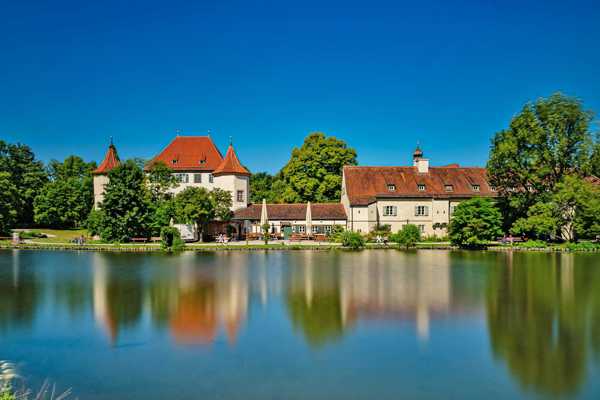Small towns in Bavaria are absolutely worth visiting, especially if you want to experience alpine views, glittering lakes, and vibrant countryside. Though tourists will enjoy the massive state's headline cities of Munich and Nuremberg, its small towns seem to have come out from the pages of a fairytale.
Medieval half-timbered houses line cobbled streets, which open out into pretty squares. In summer, colourful flowers spill out of windowboxes, while winter brings a pretty dusting of snow and plenty of atmospheric Christmas markets. The surrounding countryside is an ideal playground for summer hikers and winter sports enthusiasts alike. Read on for our favourite small towns in Bavaria.
- 1
Rothenburg ob der Tauber
Pretty walled town known for its towers

Rothenburg ob der Tauber is a medieval town in northern Bavaria, around 149 km northeast of Stuttgart. A stone wall with a covered walkway partially encloses the old town, offering views of the forested countryside. There are numerous towers along the wall – visitors are permitted to climb Röderturm, accessed via the Rödertor gate.
Many of the town’s medieval buildings line the Plönlein, where 2 more historic gates flank a yellow half-timbered house. A short stroll along cobbled lanes takes you to the Marktplatz, where the town hall’s Renaissance façade garners admiring glances. Call in at the Medieval Crime Museum and the German Christmas Museum before you leave Rothenburg ob der Tauber.
Map - 2
Oberammergau
Home of the Passion Play

Oberammergau is an attractive town in the Bavarian Alps. It is best known for staging the Passion Play, a traditional Lent tradition that takes place every 10 years. The festival dates back to a time when the plague devastated the area. In desperation, villagers vowed to perform a re-enactment of Christ’s death and resurrection in the hope that God would spare them.
Learn more about the play and see some of the props, staging and costumes in the town’s fascinating museum. Nearby, you’ll find a cobbled square flanked by traditional chalets. In summer, their windowboxes overflow with red geraniums.
Map - 3
Füssen
Follow Germany’s Romantic Road

Füssen in the Allgäu is a resort town in the Bavarian Alps. In winter, people come here to ski and snowboard on Tegelberg, a mountain in the Ammergau Alps. Located close to the Austrian border, it lies on the Via Claudia Augusta, a 2,000-year-old road constructed in Roman times, and as a result, has a long history of welcoming travellers.
Overlooking the Lech River, Hohes Schloss is a gothic castle that dominates the town’s skyline. It houses a collection of regional art. Another important museum, this time in St Mang’s Abbey, tells the story of violin and lute making in Füssen.
Map - 4
Bamberg
UNESCO-listed town that sprawls over 7 hills

Bamberg is an attractive town in northern Bavaria, around 62 km north of Nuremberg. It prospered in the 12th century, with ornate architecture serving as a testament to the wealth generated during medieval times. Thanks to many ecclesiastical and secular buildings, the town is listed as a UNESCO World Heritage site.
One of Bamberg’s most iconic attractions is the frescoed town hall. It perches in the middle of the River Regnitz and is accesible by 2 historic bridges. The Bamberg Cathedral was founded by Emperor Heinrich II in the 11th century. Don’t leave without tasting smoked beer at the Schlenkerla brewery. It’s been a local speciality since the 15th century.
Map - 5
Dinkelsbühl
Former free imperial city of the Holy Roman Empire

Dinkelsbühl is a Bavarian town located midway between the cities of Stuttgart and Nuremberg. Like the more famous Rothenburg ob der Tauber, it is a walled settlement and a popular stop on the Romantic Road.
There is a dense concentration of half-timbered medieval buildings in the old town. Admire the Rothenburg Gate, which once housed prison cells and medieval torture chambers, and the Wörnitz Tor, which is older still. Beside the Nördlingen Gate lies an old mill, now a museum.
Map - 6
Nördlingen
Walled town forming a trio with Rothenburg and Dinkelsbühl

Nördlingen was built within a meteorite crater. Parts of the rock were even used in the construction of the tower of St. George’s Church. Known as the Daniel, visitors can climb its narrow staircase to enjoy a stellar view over the old town square and surrounding half-timbered properties.
Some buildings have enjoyed multiple uses – the Klösterie was first a monastery and then a granary, while the cloth merchants would never have guessed their trading hall would be used to host visiting dignitaries before it became a bakery. A must-visit for train buffs is the Bavarian Railway Museum.
Map - 7
Lindau
Lakeshore town close to Austria and Switzerland

Lindau sits on the shore of Lake Constance, known to its German residents as the Bodensee. The old town is confined to an island, making it one of the most unique landmarks in Bavaria. Wander through its cobbled streets and you’ll soon come to the gabled town hall, built in 1422 and covered in colourfully painted murals. Nearby, the cathedral of Notre Dame is renowned for its sumptuously lavish interiors.
However, a statue of a lion and a stone lighthouse at the edge of the tiny harbour are among Lindau’s most prominent landmarks. Another must-see is a 12th-century waterfront watchtower called the Mangturm.
Map - 8
Bad Kissingen
Delightful spa town in the Franconia region

Bad Kissingen is a Bavarian spa town known for its mineral-rich water, which comes from several natural springs. Drinking water from the Rakoczy, Pandur, Maxbrunnen, and Kissinger Bitterwasser springs is believed to regulate digestion.
The town's main spa complex is KissSalis Therme, which has indoor and outdoor pools. Other notable attractions include Botenlauben Castle, a 12th-century ruin, the white and green halls of the Regent building, and the classic-style Arkadenbau.
Map - 9
Berchtesgaden
Alpine salt-mining town with a dark past

Berchtesgaden is a southern Bavarian town situated right on the Austrian border. It is best known for Hitler’s Eagle’s Nest retreat, the Kehlsteinhaus, which occupies a commanding position on a ridge overlooking the Bavarian Alps.
The town has a 500-year-long history of mining salt, so make sure to visit the Berchtesgaden Salzbergwerk. Just out of town, the Jennerbahn gondola offers breathtaking views over the Königssee. In summer, you can hike the trails of the Berchtesgaden National Park. For skiiers, lifts connect the town to the Obersalzburg and Rossfeld during winter.
Map - 10
Hohenschwangau
Castle on the shores of the Alpsee

Hohenschwangau is where the path starts for the hike up to Neuschwanstein. This fairytale castle is thought to have inspired Walt Disney – its turrets certainly bear some resemblance to its theme park counterpart.
Hohenschwangau has its own hilltop castle, which was once the summer residence of King Ludwig II. The ornate interiors of this neo-Gothic pile are awe-inspiring. You should also pay a visit to the town’s Museum of the Bavarian Kings - it overlooks a breathtaking lake called the Alpsee.
Map



















